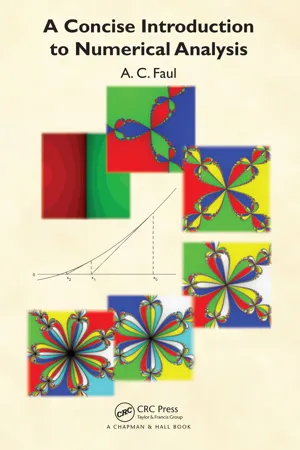
- 292 pages
- English
- ePUB (mobile friendly)
- Available on iOS & Android
A Concise Introduction to Numerical Analysis
About this book
This textbook provides an accessible and concise introduction to numerical analysis for upper undergraduate and beginning graduate students from various backgrounds. It was developed from the lecture notes of four successful courses on numerical analysis taught within the MPhil of Scientific Computing at the University of Cambridge. The book is easily accessible, even to those with limited knowledge of mathematics.
Students will get a concise, but thorough introduction to numerical analysis. In addition the algorithmic principles are emphasized to encourage a deeper understanding of why an algorithm is suitable, and sometimes unsuitable, for a particular problem.
A Concise Introduction to Numerical Analysis strikes a balance between being mathematically comprehensive, but not overwhelming with mathematical detail. In some places where further detail was felt to be out of scope of the book, the reader is referred to further reading.
The book uses MATLAB® implementations to demonstrate the workings of the method and thus MATLAB's own implementations are avoided, unless they are used as building blocks of an algorithm. In some cases the listings are printed in the book, but all are available online on the book's page at www.crcpress.com.
Most implementations are in the form of functions returning the outcome of the algorithm. Also, examples for the use of the functions are given. Exercises are included in line with the text where appropriate, and each chapter ends with a selection of revision exercises. Solutions to odd-numbered exercises are also provided on the book's page at www.crcpress.com.
This textbook is also an ideal resource for graduate students coming from other subjects who will use numerical techniques extensively in their graduate studies.
Frequently asked questions
- Essential is ideal for learners and professionals who enjoy exploring a wide range of subjects. Access the Essential Library with 800,000+ trusted titles and best-sellers across business, personal growth, and the humanities. Includes unlimited reading time and Standard Read Aloud voice.
- Complete: Perfect for advanced learners and researchers needing full, unrestricted access. Unlock 1.4M+ books across hundreds of subjects, including academic and specialized titles. The Complete Plan also includes advanced features like Premium Read Aloud and Research Assistant.
Please note we cannot support devices running on iOS 13 and Android 7 or earlier. Learn more about using the app.
Information
Table of contents
- Cover
- Half Title
- Title Page
- Copyright Page
- Dedication
- Table of Contents
- List of Figures
- Preface
- Acknowledgments
- CHAPTER 1 ▪ Fundamentals
- CHAPTER 2 ▪ Linear Systems
- CHAPTER 3 ▪ Interpolation and Approximation Theory
- CHAPTER 4 ▪ Non-Linear Systems
- CHAPTER 5 ▪ Numerical Integration
- CHAPTER 6 ▪ ODEs
- CHAPTER 7 ▪ Numerical Differentiation
- CHAPTER 8 ▪ PDEs
- Bibliography
- Index